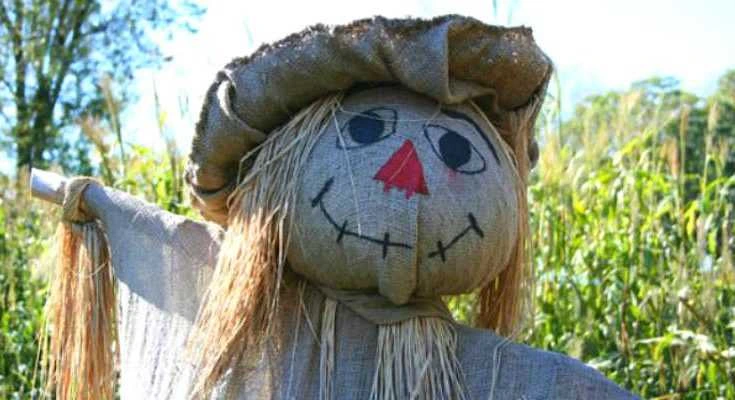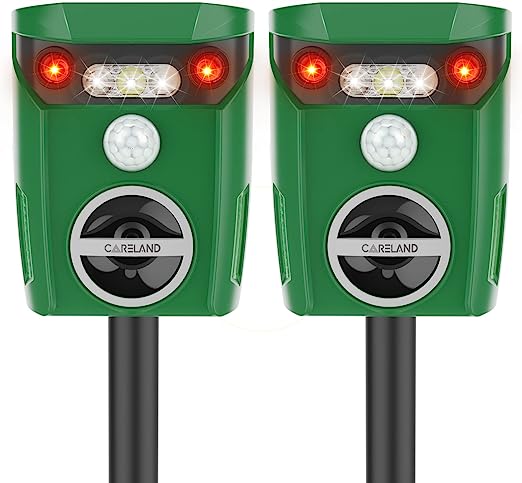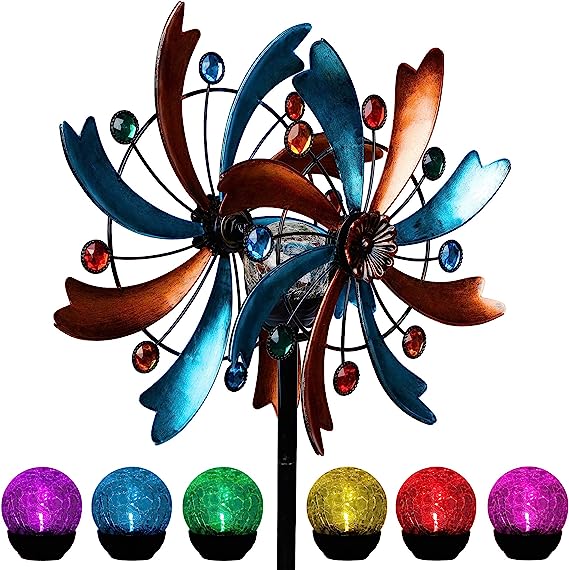Scarecrows have traditionally been used to keep crows and other intruders out of vegetable gardens and away from the produce. In ancient Egypt, scarecrows were fashioned out of wooden frames and netting and placed in the wheat fields along the Nile River valley to ward off quail. For centuries the scarecrow served a practical purpose, but now it is more than a tool to scare birds away.
But the scarecrow has become more than just a garden asset. It is also a staple of fun autumn décor. Whether displayed in the garden to protect seeds and plants) or adorning the front porch surrounded by pumpkins and hay bales, making a scarecrow can be fun, simple, and budget-friendly.
Designing Your Scarecrow
Choosing a Scarecrow Design that Fits Your Garden Aesthetic
When designing your scarecrow, it’s important to consider a design that complements the overall aesthetic of your garden. A well-designed scarecrow can not only serve as a functional garden guardian but also add a touch of charm and personality to your outdoor space. Here are some factors to keep in mind when selecting a scarecrow design:
Traditional vs. Creative
Decide whether you prefer a traditional scarecrow design with the classic straw-filled body and floppy hat, or if you want to get more creative and explore unique variations. Traditional designs lend a rustic and nostalgic feel, while creative designs allow you to express your individuality and add a whimsical touch.

Theme and Season
Consider incorporating a theme into your scarecrow design that aligns with your garden or the current season. For example, you could create a scarecrow dressed as a farmer for a farm-themed garden or a scarecrow adorned with colorful autumn leaves for a fall display. Matching the design to the theme can enhance the overall visual appeal.

Materials and Colors
Choose materials and colors that blend harmoniously with your garden environment. If you have a natural and earthy garden, opt for natural-looking materials like straw, burlap, or recycled fabric. For a vibrant and colorful garden, consider using brightly colored fabrics or painting the scarecrow in eye-catching hues.
Considerations for Size and Shape
The size and shape of your scarecrow can significantly impact its effectiveness and visual appeal. Here are some considerations to keep in mind:
- Proportions: Ensure that the size of your scarecrow is proportional to the surrounding plants and structures. A scarecrow that is too small may go unnoticed, while one that is excessively large might appear out of place. Aim for a size that is visually balanced with the rest of your garden.
- Visibility: The primary purpose of a scarecrow is to deter pests and birds. To maximize its effectiveness, choose a size and shape that provides good visibility from various angles. Make sure it stands out amidst the plants so that birds and animals can easily spot it.
- Stability: Consider the stability of your scarecrow design. Depending on your garden’s weather conditions, you may need to ensure that the scarecrow is sturdy enough to withstand wind or rain. Reinforce the structure or use additional supports if needed to prevent it from tipping over or getting damaged.
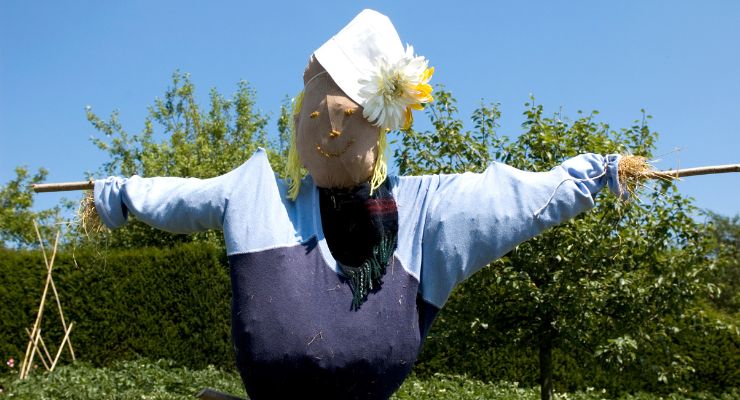
Gathering Materials and Tools for Your DIY Scarecrow
- Straw or hay
- Old clothes, such as a flannel shirt, overalls, or tattered jeans
- Burlap or old pantyhose
- Rubber bands or twine
- Safety pins
- Permanent marker or paint pens
Step-by-Step Instructions for a Basic Scarecrow
- First, make sure that any shirt or overall buttons are properly fastened. This will ensure that the scarecrow takes the proper shape.
- Next, tie off the ends of the shirt sleeves and pants legs with twine or a tightly wound rubber band.
- Begin stuffing hay or straw into the clothing. The clothes need to be stuffed very full. Old leaves can also be used to stuff the scarecrow if hay or straw is not available.
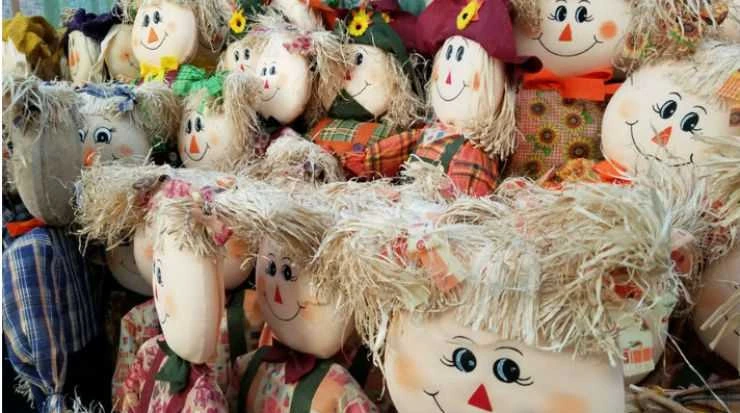
- After the clothing has been stuffed, try putting long strips of hay into the tied-off shirt sleeves and pants legs and leave them sticking out to give the illusion of hands and feet.
- Next, fashion a burlap sack (or the top part of an old pantyhose) into the shape of a head. The scarecrow’s head should be 8 to 10 inches in diameter, depending on the size of the scarecrow.
- Fill it with straw or leaves until it takes shape. Burlap is durable enough to be filled with straw, but if using hosiery, try old leaves or even cotton so that it does not tear.
- Place the scarecrow’s head on top of the body and fasten it in place with safety pins. Try adding a bandana or kerchief around the neck for extra décor and to hide the pins. Don’t forget the straw hat!
- Finally, give the scarecrow a face for the finished look. Be creative! Try gluing on cute buttons for eyes or use triangle and square shapes for noses. The best decorative scarecrows are usually whimsical! If painting or drawing a face, be sure to use permanent markers or paint pens.

Right Place for your DIY Scarecrow
When it comes to positioning your scarecrow, strategic placement plays a crucial role in maximizing its effectiveness in deterring pests and protecting your garden.
Identify areas where pests are most likely to target your plants. By placing the scarecrow in these areas, you create a strong visual deterrent that discourages pests from causing damage.
Elevate your scarecrow by using a sturdy pole or stand. Position it at a height that allows it to tower over your plants, making it easily visible to pests. This heightened visibility increases its impact as a deterrent.
To post it in the yard or garden, make a cross-shaped post out of two boards that are nailed together perpendicularly. Dig a hole 6 inches into the ground and place the bar in the hole. Attach the scarecrow to the post using nails or twine.
Avoid the habituation of pests by periodically moving the scarecrow to different areas of your garden. By introducing a sense of unpredictability, you maintain its effectiveness and prevent pests from becoming accustomed to its presence.
Enhance the scarecrow’s effectiveness by combining its placement with companion planting techniques. Select plants that naturally repel pests and plant them near the scarecrow, creating an additional layer of defense for your garden.

Maintenance Tips to Ensure Longevity
Conduct routine inspections of your scarecrow to identify any signs of damage, wear, or pest activity. Check the frame, stuffing, and clothing for tears, loose parts, or deterioration. Address any issues promptly to prevent further damage.
Apply a weatherproofing agent to the scarecrow frame and clothing to protect it from the elements. This helps prevent rotting, fading, and damage caused by rain, wind, or sunlight. Opt for materials that are resistant to moisture and fading.
Repair or replace any damaged or worn-out parts of the scarecrow as soon as you notice them. Reinforce loose joints, strengthen weak areas, and replace flattened or damaged stuffing. Patch or replace torn or deteriorated clothing.
Modify the scarecrow’s appearance and accessories to match the changing seasons. Consider dressing it in warmer clothing during the winter or adding seasonal decorations to maintain its visual appeal throughout the year.
Keep your scarecrow clean by periodically dusting off dirt or debris. Use a brush or a damp cloth to gently clean the surface, avoiding the use of harsh chemicals or excessive moisture that may damage the materials.
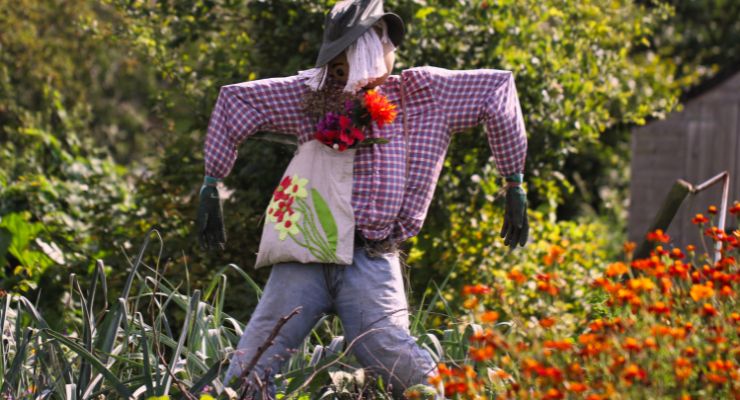
Enhancing Scarecrow Effectiveness
Apply natural pest repellents to the scarecrow or its surroundings to enhance its effectiveness. Essential oils, such as peppermint, lavender, or garlic, can be sprayed on the scarecrow or nearby plants to repel pests. Consider using organic or homemade repellents to maintain an eco-friendly garden environment.
Hang wind chimes, and old plastic bags near the scarecrow to create gentle sounds that can startle pests. The tinkling sound helps create an unpredictable environment, making pests more cautious about approaching your garden.
Install motion-activated devices, such as sprinklers or noise-emitting devices, near the scarecrow. When pests come near, these devices activate, startling them and deterring them from entering your garden. This adds an extra layer of deterrence beyond the scarecrow itself.
How do you make a scarecrow movable? Attach reflective materials, such as aluminum foil strips, reflective tape, or old CDs, to the scarecrow’s clothing or nearby objects. These reflective surfaces create flashes of light as they move in the breeze, disorienting and deterring pests from approaching your garden.

Place pinwheels or colorful streamers near the scarecrow to create movement and visual distractions. The constant motion and changing patterns make it challenging for pests to focus on their intended targets, reducing their interest in your garden.
Harvesting the Benefits – Scarecrows as Delightful Decorations and Powerful Pest Deterrents
Creating a scarecrow is not only one of the delightful fall decorating ideas but also an effective method of pest control for your garden. While scarecrows can serve as charming decorative pieces, they also play a vital role in deterring pests and protecting your plants.
If the scarecrow is simply decorative, it can sit in a porch chair surrounded by pumpkins, pumpkin head, or lean against the siding of the house. For most of us, no fall or Halloween décor is complete without a scarecrow.
If you are looking for more fun ways to celebrate this season, check out our guide for cornboards, pretend play toys, and other things you can do in the garden this fall!
By following the steps outlined in this guide, you have learned how to design and customize your scarecrow to suit your garden’s needs. With the incorporation of supplementary methods like sound, motion, and reflective elements, you can reinforce its deterrent power and create an environment that is uninviting to pests.
So, as you enjoy the creative process of making your scarecrow and displaying it proudly on your porch or in your garden, remember the real impact it has as a pest repeller. With its watchful gaze and intimidating presence, the scarecrow serves as a natural and eco-friendly solution to protect your plants and maintain the beauty of your garden.
In conclusion, by crafting your own scarecrow and implementing the techniques discussed, you can enjoy the benefits of both a charming fall decoration and an effective pest repellent. Embrace the whimsy, creativity, and practicality that your handmade scarecrow brings to your garden. Happy crafting, and may your scarecrow stand tall, keeping pests at bay, and preserving the splendor of your garden throughout the seasons.
